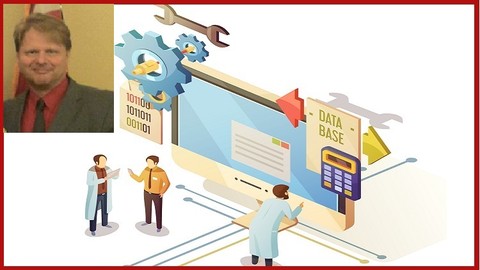
C# Database Driven WinForm Apps (step by step projects)
C# Database Driven WinForm Apps (step by step projects), available at $79.99, has an average rating of 4.5, with 153 lectures, based on 343 reviews, and has 4101 subscribers.
You will learn about Students will understand the basics of database programming using C# and MS Access database. Students will become familiar with database programming concepts. Students will be able to create small database-driven desktop apps. Students will understand basics of database concepts. Students will be able to create and modify Windows Forms and bind form objects with database objects. Students will be ready to tackle more complex projects. This course is ideal for individuals who are Beginner C# developer who wants to create small database driven Windows Forms apps or Selft Taught programmers or students interested in C# and databases or Anyone seeking to get entry level position or internship, or Students who like to learn by hands-on examples. It is particularly useful for Beginner C# developer who wants to create small database driven Windows Forms apps or Selft Taught programmers or students interested in C# and databases or Anyone seeking to get entry level position or internship, or Students who like to learn by hands-on examples.
Enroll now: C# Database Driven WinForm Apps (step by step projects)
Summary
Title: C# Database Driven WinForm Apps (step by step projects)
Price: $79.99
Average Rating: 4.5
Number of Lectures: 153
Number of Published Lectures: 153
Number of Curriculum Items: 153
Number of Published Curriculum Objects: 153
Original Price: $19.99
Quality Status: approved
Status: Live
What You Will Learn
- Students will understand the basics of database programming using C# and MS Access database.
- Students will become familiar with database programming concepts.
- Students will be able to create small database-driven desktop apps.
- Students will understand basics of database concepts.
- Students will be able to create and modify Windows Forms and bind form objects with database objects.
- Students will be ready to tackle more complex projects.
Who Should Attend
- Beginner C# developer who wants to create small database driven Windows Forms apps
- Selft Taught programmers or students interested in C# and databases
- Anyone seeking to get entry level position or internship,
- Students who like to learn by hands-on examples.
Target Audiences
- Beginner C# developer who wants to create small database driven Windows Forms apps
- Selft Taught programmers or students interested in C# and databases
- Anyone seeking to get entry level position or internship,
- Students who like to learn by hands-on examples.
WARNING! Some students reported that the MS Access database used in this course will not work with the current version MS Office 365, even with legacy MS Access database redistributable engine. In majority of cases the issue is solved by installing 2016 version of the MS Access database redistributable engine (please see Q&A section of the course). If this doesn’t work for you and you experience problems after purchasing the course, please note that Udemy offers 30-day money back guarantee.
I created this course with a C# beginner in mind. Someone, who knows the basic C# concepts, and knows his way around loops, conditional statements, arrays, and very basics of object oriented programming, but never really had a chance to incorporate any of it with a relational Database project. If that describes you, then this is definitely a course for you.
For this course, I decided to use a Microsoft Access database, as that is a common database small business use around the world. Now, full disclosure: we won’t be creating any earth shattering application and there will be a lot of room for improving our code. What we ARE going to be doing is LEARNING how to use with C# with MS Access, and we’ll use a simple, but fairly common scenario – a small books database app.
The goal of this course is three fold
-
First, is to show you how things work
-
Second, help you understand how things work under the hood.
-
And third, to drill the basics so that they become a second nature to you.
This course concentrates solely on using Access database with C
We will use Windows Forms as the user Interface and we’ll use form events to code the application logic to. This way, we won’t get distracted with million other little things that come into play for truly well designed commercial app. Like I said, the goal here is to LEARNthe basics, and to RETAINthe knowledge.
From my own experience, from the beginners point of view, nothing is worse than taking a course to learn the basics, only to suddenly be introduced to a dozens of advanced real world concepts, that completely derail you from learning what you came here to learn in the first place…which is, the basics. What good is it for a beginner to watch someone build professional grade app when three quarter of the stuff presented goes right over your head? Not in this course.
However, with that being said, if you go through this course, and if you code along, I am absolutely sure that at the end, you will have great foundation to build on, and you will be able to move to more sofisticated applications and coding styles.
The course consists of several sections. The first few sections introduce the basic concepts, such connecting to database, browsing through the records, binding database fields with form objects in the windows forms and other core concepts related to databases as well as windows forms.
First project is a small Data Entry application. This project does not include database yet. We will create a simple data entry form and explore few properties and form objects. This project serves as a simple introduction or a refresher, and if you are familiar with basics of windows forms and the concept of properties and events, then you can safely skip this project. However, there still may be a few things you could learn from this project, as we will be working with timer, key press events, mouse events, and form elements in the run time.
Second project will be a mix of theory and practice. We’ll spend a few minutes going through some basic theory where we will discuss some basic database concepts, SQL commands, and C# database objects and after each lesson, I will demonstrate a practical use of each of the concepts.
In our third project, we start putting the theory into practical use. It’ll be just a simple project that loads data into our form from one table, but we will see in action how to connect to the database and how to select records from the table. Ir will also be a little departure from previous examples, as we will use a different database.
Fourth project is na SQL tester. Here, we will be able to test SQL commands. We’ll use all the knowledge we acquired thus far, and introduce some cool techniques in the Windows Forms allowing us to create form elements at run time. And, we will have a small, but functional practice environment for SQL commands.
Fifth project is the last, and most comprehensive one. We will create a small books database app. Until this project, we were only displaying records, but now, we will learn to add new records, edit or delete existing records, we will work with multiple forms and tables, put in place an application state for different actions – such as enable and disable controls based on user’s action, and also learn how to pass data from one form to another.
This whole course is designed as follow along course. Meaning, you are encouraged to code along with me. Everything is on the video, there are no code snippets being magically pasted into the Visual Studio. Also, I don not want you to just learn the concepts and then forget them a week later. I want you to remember and retain what you learn in this course.
And let’s face it – that is only possible when you not only work on the project along with me, but also try to do the exercises. Trying to solve problems on your own is at the core of learning to program. However, I won’t just leave you figure things on your own, I am well aware that sometimes it may feel overwhelming. So I will also show you my solutions.
And one more thing that makes or breaks learning to program – using what you learn, and using it frequently. Therefore, I code even the repetitive things from scratch and I don’t simply just refer you to previous lessons. But that means, that if you just watch the course, it will feel repetitive. However, if you actually code along, I guarantee you will feel like you learn, and also REMEMBER what you learned.
But, If you prefer more instructional videos, that show everything once and move faster, then this course is not for you. Please keep that in mind before purchasing the course. I encourage you to watch some of the sample videos so you get a feel for the course structure and my teaching style.
Now, I made the videos short and to the point. Most videos are only around 5 minutes long. That is deliberate, so each video is a small learning step that is easy to follow.
Alright, there’s a lot of coding to be done. So let’s get to it!
Course Curriculum
Chapter 1: Introduction
Lecture 1: Introduction
Chapter 2: Data Entry Project
Lecture 1: Project Intro
Lecture 2: Building The Form Part 1
Lecture 3: Building the Form Part 2
Lecture 4: Clearing and Exiting the Form
Lecture 5: Adding the Timer
Lecture 6: Timer Tick Event
Lecture 7: Start Button Event
Lecture 8: Pause Button Event
Lecture 9: Data Entry Section
Lecture 10: Setting Up KeyPress Event
Lecture 11: KeyPress Event Part 1
Lecture 12: KeyPress Event Part 2
Lecture 13: Mouse Events
Lecture 14: EXERCISE – Add Mouse Event for Multiple Buttons
Lecture 15: Initializing Component Method
Chapter 3: Databases, C# Database Objects – Theory and Practical Examples
Lecture 1: Database Theory Part 1
Lecture 2: Database Theory Part 2
Lecture 3: Overview Of C# Database Objects
Lecture 4: Connection String Overview
Lecture 5: Connection String Example
Lecture 6: Command And Data Adapter Overview
Lecture 7: DataTable Overview
Lecture 8: Command Object Example
Lecture 9: Data Adapter Example
Lecture 10: DataTable Example
Lecture 11: Data Binding Overview
Lecture 12: Data Binding Exercise
Lecture 13: CurrencyManager Overview
Lecture 14: CurrencyManager Example
Lecture 15: Using Wizard to connect to DB and bind form objects
Lecture 16: EXERCISE – USING C# DATABASE OBJECTS (NorthWind Database) – INSTRUCTIONS
Lecture 17: EXERCISE – NorthWind – Creating the Form
Lecture 18: EXERCISE – NorthWind – Adding Database Objects
Lecture 19: EXERCISE – NorthWind – Data Binding
Lecture 20: EXERCISE – NorthWind – Currency Manager
Chapter 4: SQL Tester Project
Lecture 1: Intro
Lecture 2: Creating the Form
Lecture 3: Connecting to Database
Lecture 4: C# Database Objects
Lecture 5: Running the Program
Chapter 5: Book Database Search Project
Lecture 1: Intro
Lecture 2: Creating the form
Lecture 3: Creating Buttons Programmatically Part 1
Lecture 4: Creating Buttons Programmatically Part 2
Lecture 5: Connection String and SQL Query Command
Lecture 6: Finishing SQL Query Command
Lecture 7: Database Objects
Lecture 8: Running the Program
Chapter 6: Books Management System – CRUD Project
Lecture 1: Intro
Lecture 2: Authors – Creating the Form
Lecture 3: Authors – Adding Database Objects
Lecture 4: Authors – Navigating Between Records
Lecture 5: Authors – Setting up Save and Delete Events
Lecture 6: Authors – Application States Intro
Lecture 7: Authors – Coding Application States
Lecture 8: Authors – Working with Application States
Lecture 9: Authors – Validating Input
Lecture 10: Authors – More Input Validation
Lecture 11: Authors – KeyPress Event
Lecture 12: Authors – Error Handling
Lecture 13: EXERCISE – PUBLISHERS – INSTRUCTIONS
Lecture 14: EXERCISE – Publishers – Creating the Form
Lecture 15: EXERCISE – Publishers – Adding Database Objects
Lecture 16: EXERCISE – Publishers – Data Binding and CurrencyManager
Lecture 17: EXERCISE – Publishers – Application States
Lecture 18: EXERCISE – Publishers – Input Validation
Lecture 19: EXERCISE – Publishers – Navigating Through Records
Lecture 20: Authors – Saving Records
Lecture 21: Authors – Bug Fix – Saving Record
Lecture 22: Authors – Deleting Records
Lecture 23: Authors – Adding New Records
Lecture 24: Authors – Adding New Records – Changing Application State
Lecture 25: Authors – Adding New Records – Record Position
Lecture 26: Authors – Final Adjustments
Lecture 27: EXERCISE – PUBLISHERS – CRUD OPERATIONS – INSTRUCTIONS
Lecture 28: EXERCISE – Publishers – Adding Record Navigation
Lecture 29: EXERCISE – Publishers – Saving Records
Lecture 30: EXERCISE – Publishers – Saving Records (testing)
Lecture 31: EXERCISE – Publishers – Adding and Deleting Records
Lecture 32: EXERCISE – Publishers – Changing Application States
Lecture 33: Publishers – Adding Search Functionality to the Form
Lecture 34: Publishers – Coding Search Functionality
Lecture 35: EXERCISE – AUTHORS – ADDING SEARCH FUNCTIONALITY – INSTRUCTIONS
Lecture 36: EXERCISE – Authors – Adding Seach To The Form
Lecture 37: EXERCISE – Authors – Coding Search Functionality
Lecture 38: Authors – Bug Fix – Edit and Cancel Events
Lecture 39: Authors – Bug Fix – Add New Record
Lecture 40: Publishers – Bug Fix – Cancel Adding New Record
Lecture 41: Titles – Introduction
Lecture 42: Titles – Creating the Form
Lecture 43: Titles – Adding C# Database Objects
Lecture 44: Titles – Navigating Between Records
Lecture 45: Titles – Application State
Instructors
-
Pavol Almasi
Computer Programmer at Berkshire Hathaway Company
Rating Distribution
- 1 stars: 5 votes
- 2 stars: 1 votes
- 3 stars: 18 votes
- 4 stars: 111 votes
- 5 stars: 208 votes
Frequently Asked Questions
How long do I have access to the course materials?
You can view and review the lecture materials indefinitely, like an on-demand channel.
Can I take my courses with me wherever I go?
Definitely! If you have an internet connection, courses on Udemy are available on any device at any time. If you don’t have an internet connection, some instructors also let their students download course lectures. That’s up to the instructor though, so make sure you get on their good side!
You may also like
- Best Video Editing Courses to Learn in March 2025
- Best Music Production Courses to Learn in March 2025
- Best Animation Courses to Learn in March 2025
- Best Digital Illustration Courses to Learn in March 2025
- Best Renewable Energy Courses to Learn in March 2025
- Best Sustainable Living Courses to Learn in March 2025
- Best Ethical AI Courses to Learn in March 2025
- Best Cybersecurity Fundamentals Courses to Learn in March 2025
- Best Smart Home Technology Courses to Learn in March 2025
- Best Holistic Health Courses to Learn in March 2025
- Best Nutrition And Diet Planning Courses to Learn in March 2025
- Best Yoga Instruction Courses to Learn in March 2025
- Best Stress Management Courses to Learn in March 2025
- Best Mindfulness Meditation Courses to Learn in March 2025
- Best Life Coaching Courses to Learn in March 2025
- Best Career Development Courses to Learn in March 2025
- Best Relationship Building Courses to Learn in March 2025
- Best Parenting Skills Courses to Learn in March 2025
- Best Home Improvement Courses to Learn in March 2025
- Best Gardening Courses to Learn in March 2025






















